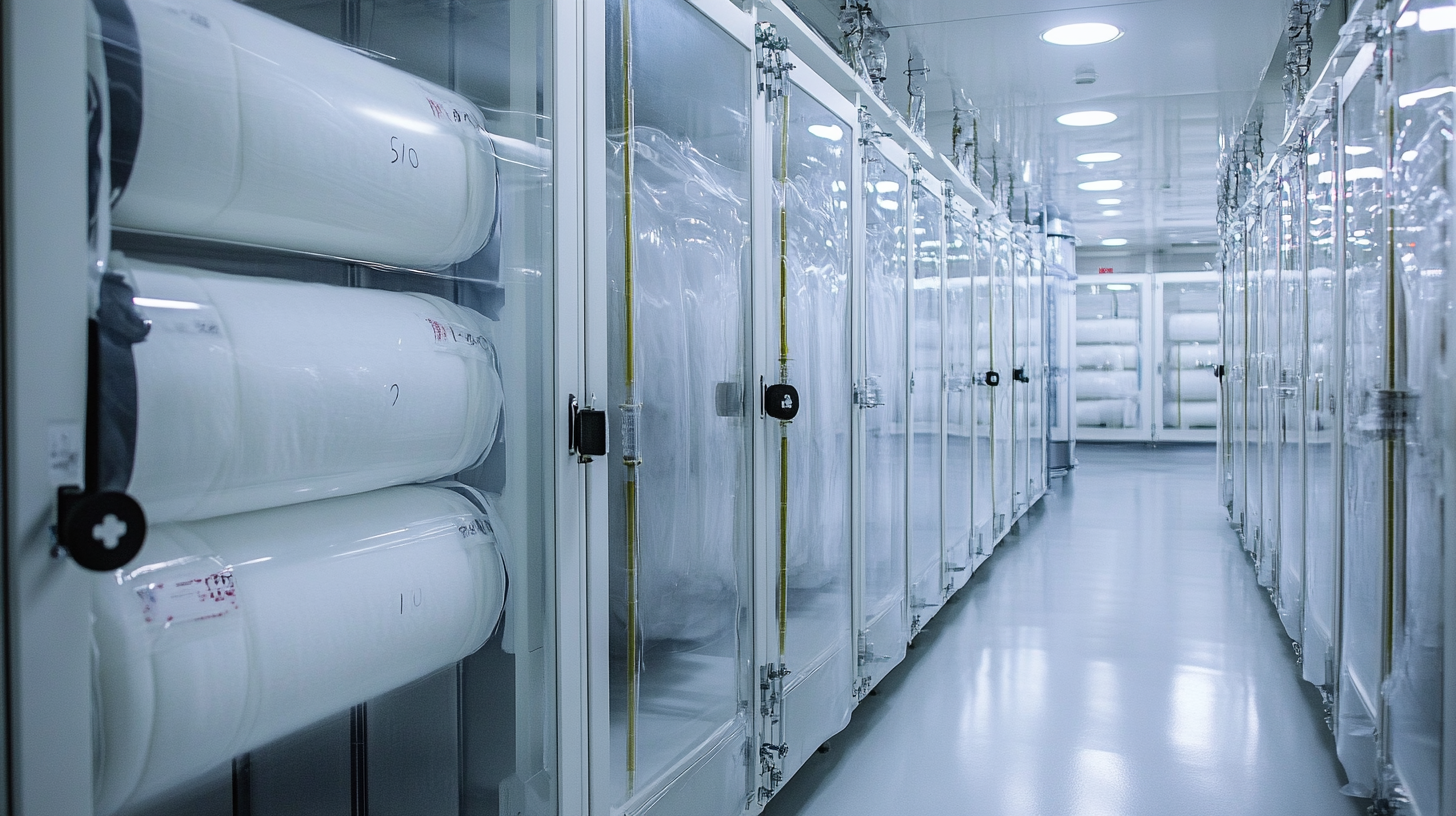- Home
- Products
- Services
- Product concept development
- Engineering
- Design for manufacturability
- Regulatory services
Read more - Material selection and formulation
- Prototyping
- Testing and validation
Read more - Production process development
- Custom tooling
- Manufacturing
- Finishing operations
- Assembly
- Packaging
- Private labeling
- Sterilization
Read more
- Resources
- Careers
- Search
Eto Sterilization Versus Traditional Methods Which is More Effective for Global Supply Chain Needs
In today's global supply chain landscape, the demand for effective sterilization methods has never been more critical. With the rise of complex logistics and the need for consistent product safety, businesses are reevaluating the sterilization processes they employ. One method that has gained significant attention is ETO Sterilization, a technology known for its efficacy in eliminating a broad spectrum of microorganisms without compromising the integrity of sensitive medical and pharmaceutical products. As companies aim to enhance their operational efficiency and ensure compliance with stringent safety standards, understanding the advantages of ETO Sterilization over traditional methods becomes paramount.
Traditional sterilization techniques, while time-tested, often come with limitations such as long processing times, material compatibility issues, and potential residues that can affect product performance. In contrast, ETO Sterilization offers a flexible solution that caters to the diverse needs of modern supply chains. This blog will explore the effectiveness of ETO Sterilization compared to conventional sterilization methods, highlighting its role in supporting global supply chain needs and ensuring that products meet the highest safety and quality standards. Through this examination, we aim to provide insights that will help stakeholders make informed decisions about the best sterilization strategies for their unique requirements.

Eto Sterilization: An Overview of the Technology and Its Applications
Ethylene oxide (EtO) sterilization has emerged as a powerful method in the healthcare and medical device sectors, fulfilling a critical role in ensuring the safety and efficacy of products. This technology utilizes ethylene oxide gas to eliminate microorganisms, making it particularly effective for heat-sensitive items that cannot withstand traditional sterilization methods, such as steam or dry heat. EtO sterilization boasts a high penetration ability, allowing it to effectively sterilize complex devices with intricate designs and lumens. One of the most significant applications of EtO sterilization is in the medical device industry, where it is commonly employed to sterilize surgical instruments, implants, and diagnostic tools. The versatility of this method extends beyond medical applications; it is also utilized in pharmaceuticals, food packaging, and even in some consumer products that require sterilization without altering their characteristics. As global supply chains continue to expand, the demand for reliable sterilization methods has never been more crucial, making EtO an increasingly relevant technology. In comparison to traditional methods, EtO sterilization offers a unique advantage, especially where materials are sensitive to heat or moisture. The ambient conditions employed during the process can be meticulously controlled, allowing manufacturers to ensure that even the most delicate items are safely sterilized without damage. As stricter regulations and higher standards for sterilization practices evolve globally, EtO continues to stand out as a preferred option for companies looking to maintain product reliability while meeting increasing hygiene expectations.

Comparative Analysis of Eto Sterilization and Traditional Methods
Ethylene oxide (EtO) sterilization has garnered significant attention in recent years as a viable option for meeting the demands of the global supply chain. A comparative analysis reveals that while traditional sterilization methods, such as steam and dry heat, have long been trusted in the industry, they may not adequately address the complexities associated with modern medical devices and pharmaceuticals. According to a report from the World Health Organization, approximately 40% of medical devices are sterilized using EtO, underscoring its critical role in healthcare logistics.
One of the key advantages of EtO sterilization is its ability to penetrate materials that are sensitive to heat and moisture, making it ideal for sterilizing complex instruments like laparoscopic tools or electronic medical devices. The Sterilization Association emphasizes that EtO can achieve a sterility assurance level (SAL) of 10^-6, which is comparable to many traditional methods. However, it is crucial to consider the regulatory landscape, as the Environmental Protection Agency has placed restrictions on EtO emissions due to its potential health risks, prompting companies to adopt best practices to mitigate these impacts.
Furthermore, the economic considerations play a vital role in the evaluation of sterilization methods. A study by the Journal of Healthcare Engineering indicates that EtO sterilization often proves to be more cost-effective in the long term, especially for high-value products that require specific sterilization conditions. The initial setup costs for EtO chambers can be higher than those for traditional methods, but the efficiency and effectiveness of the sterilization process can lead to lesser rework and waste, ultimately favoring supply chain productivity.

Impact of Sterilization Methods on Global Supply Chain Efficiency
The choice of sterilization methods has a profound impact on the efficiency of global supply chains, particularly in industries such as pharmaceuticals, food production, and medical device manufacturing. Traditional methods, including autoclaving and chemical sterilization, have long been the staple in ensuring product safety and compliance with health regulations. However, these methods can be time-consuming and labor-intensive, often leading to bottlenecks in production schedules. On the other hand, emerging technologies such as Eto (ethylene oxide) sterilization offer a more efficient approach, allowing for effective sterilization with shorter cycle times and broader compatibility with various materials.
Eto sterilization stands out not only for its speed but also for its ability to penetrate complex geometries and porous materials. This versatility is crucial in a global supply chain where products may be packed in intricate configurations or made from sensitive materials that traditional methods might not adequately sterilize. Furthermore, the adaptability of Eto sterilization enables manufacturers to meet regulatory requirements without sacrificing production timelines. As companies strive for greater operational efficiency and cost-effectiveness, the choice of sterilization method directly influences their ability to respond to market demands swiftly.
Moreover, the environmental considerations tied to sterilization methods cannot be overlooked. As sustainability becomes a cornerstone of corporate strategies, industries are leaning towards sterilization techniques that minimize waste and reduce carbon footprints. Eto sterilization, when implemented properly, can significantly lower the environmental impact compared to conventional methods, further enhancing the brand reputation and consumer trust. Ultimately, selecting the right sterilization method is not merely a technical decision; it is a strategic move that shapes global supply chain performance and aligns with broader sustainability goals.

Regulatory Considerations for Eto Sterilization in Supply Chains
The recent regulatory developments surrounding ethylene oxide (EtO) sterilization are poised to have significant implications for global supply chains. The Environmental Protection Agency (EPA) has finalized new regulations aimed at limiting emissions from sterilization facilities, a move that reflects growing concerns over environmental and public health. These regulations may compel medical device manufacturers to reassess their sterilization processes, as compliance becomes a critical factor in their operational strategies.
Amid these changes, the FDA has also recognized new standards for medical device sterilization, illustrating a concerted effort to align safety and efficacy with environmental responsibility. As the healthcare industry grapples with the rising demand for effective sterilization methods, understanding the regulatory landscape becomes paramount. Manufacturers need to navigate not only the technical aspects of sterilization but also the increasingly complex compliance requirements that accompany EtO usage.
In this evolving context, manufacturers are exploring innovative approaches to meet stringent regulatory standards while ensuring high-quality sterilization. This includes assessing alternative sterilization methods that may offer greater sustainability, in addition to fostering dialogue around best practices and emerging technologies. As they adapt to the shifting regulatory environment, the focus will undoubtedly be on maintaining a balance between efficacy in sterilization and commitment to environmental stewardship.
Future Trends in Sterilization Techniques for Global Logistics
As global logistics continues to evolve, the need for effective sterilization techniques has become increasingly crucial. The rise of e-commerce and international shipping necessitates reliable methods to ensure the safety and viability of products transported across borders. Ethylene oxide (EO) sterilization is emerging as a frontrunner in this domain, offering a versatile solution that traditional methods struggle to match. According to the World Health Organization, EO sterilization is effective against a broad spectrum of pathogens, making it invaluable for industries such as pharmaceuticals and medical devices, where sterility is paramount.
Future trends in sterilization techniques highlight the adoption of more advanced technologies that cater to the demands of the global supply chain. For instance, the market for sterilization technologies is projected to reach approximately $9.5 billion by 2026, according to a report by Research and Markets. Companies are increasingly recognizing the importance of integrating sustainable practices within these technologies. Innovations such as low-temperature hydrogen peroxide and ozone sterilization are gaining traction, offering effective alternatives that minimize environmental impact while ensuring product safety.
Additionally, automation and artificial intelligence are likely to play significant roles in revolutionizing sterilization processes. Real-time monitoring systems can enhance efficiency and traceability, addressing the growing consumer demand for transparency in supply chains. As logistics companies begin to implement these cutting-edge solutions, the role of sterilization will remain pivotal in ensuring that products not only reach their destinations safely but also meet stringent safety standards across various sectors.







